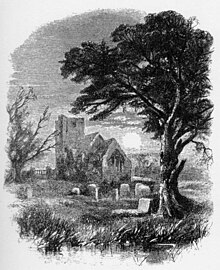"Claribel: A Melody" is an early poem by Alfred Tennyson, first published in 1830.[1]
Text

In the 1830 and 1842 editions the poem is in one long stanza, with a full stop in the 1830 edition after line 8; the 1842 edition omits the full stop.[1] The name "Claribel" may have been suggested by Spenser,[2] or Shakespeare.[3][1]
Where Claribel low-lieth
The breezes pause and die,
Letting the rose-leaves fall:
But the solemn oak-tree sigheth,
Thick-leaved, ambrosial,
With an ancient melody
Of an inward agony,
Where Claribel low-lieth.At eve the beetle boometh
Athwart the thicket lone:
At noon the wild bee[a] hummeth
About the moss’d headstone:
At midnight the moon cometh,
And looketh down alone.
Her song the lintwhite swelleth,
The clear-voiced mavis dwelleth,
The callow throstle[b] lispeth,
The slumbrous wave outwelleth,
The babbling runnel crispeth,
The hollow grot replieth
Where Claribel low-lieth.
Notes
References
- ^ a b c Collins, ed. 1900, p. 2.
- ^ The bride of Phaon in The Faerie Queene, ii., iv.
- ^ Claribel, daughter of Alonso, wife to the King of Tunis in the backstory of The Tempest.
Sources
- Collins, John Churton, ed. (1900). The Early Poems of Alfred, Lord Tennyson. London: Methuen & Co. pp. 2–3.
 This article incorporates text from this source, which is in the public domain.
This article incorporates text from this source, which is in the public domain.
Further reading
- Duncan-Jones, Katherine (1971). "A Note on Tennyson's "Claribel"". Victorian Poetry. 9: 348–350.
External links
- Robins, J. D. (ed.). "Claribel". Representative Poetry Online. University of Toronto Libraries.














